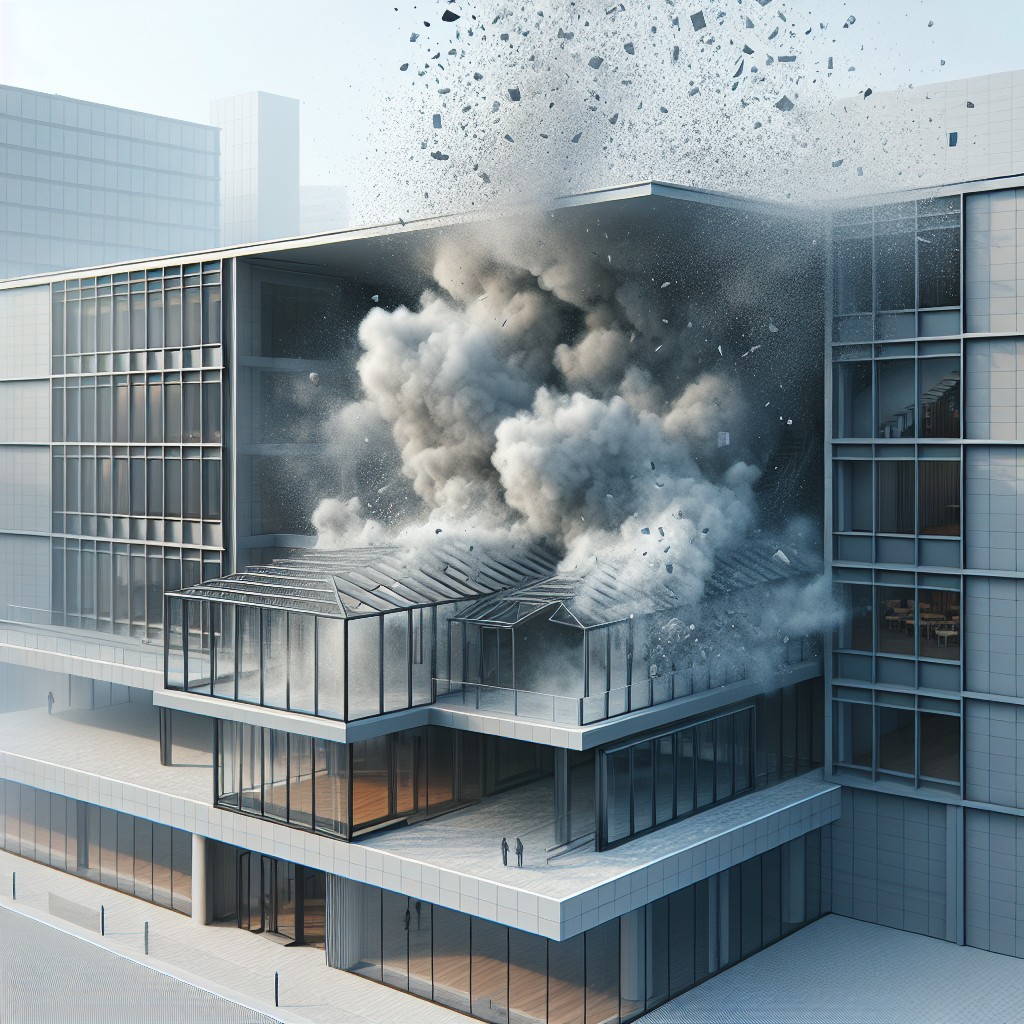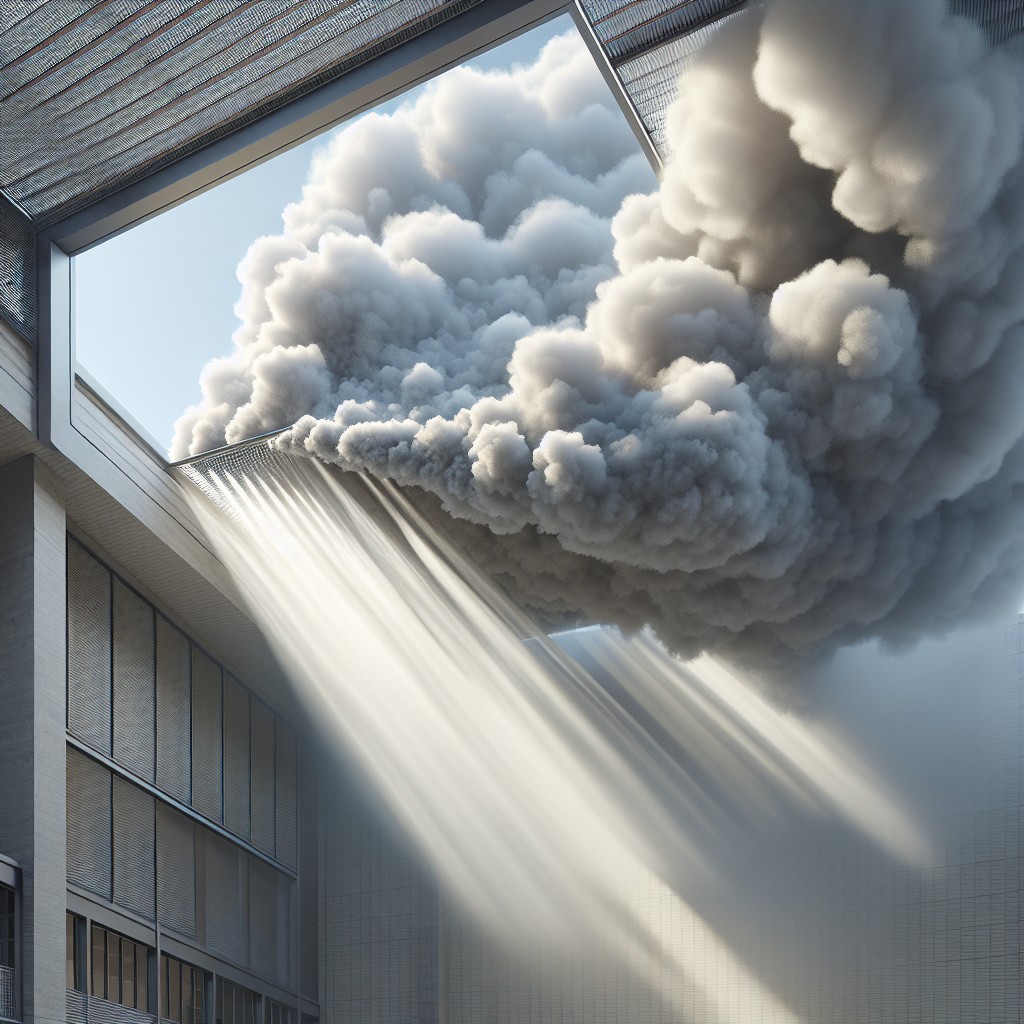Last updated on
Explore why properly designed and maintained roofs become crucial in dispersing smoke because they play a significant role in maintaining a cleaner air environment within a home.
When a fire incident occurs, the rapid removal of smoke is critical to minimize damage and ensure safety. As smoke naturally rises due to the heat, the roof serves as a vital route for its escape. Implementing strategic openings like vents and skylights can dramatically enhance this natural process, drawing smoke away through well-designed ventilation systems.
By utilizing the “drop the roof” technique, the concentration of smoke can be significantly reduced, thus providing clearer and safer paths for evacuation. Understanding the natural buoyancy of hot gases and the principles of convection can further optimize smoke egress methods.
This article delves into the mechanics of smoke rise and dispersal, exploring practical solutions for efficient smoke clearance in the event of a fire.
Key takeaways:
- Smoke rises due to higher temperature, making the roof an ideal escape route.
- Strategic openings, such as vents or skylights, create pathways for smoke to exit.
- Properly designed systems mitigate the layering effect of smoke accumulation.
- Drop the roof tactic reduces smoke density, allowing for clearer egress paths.
- Buoyancy of hot gases and principles of convection draw smoke out.
Understanding “Drop the Roof and Let the Smoke Clear”

The phrase in question typically refers to an emergency strategy designed to improve visibility and reduce toxic fumes during a fire by venting smoke through the roof. Here are the key concepts:
- Smoke rises due to its higher temperature relative to the surrounding air, making the roof an ideal escape route.
- Strategic openings, such as vents or skylights, can be actuated to create pathways for smoke to exit.
- Properly designed systems mitigate the layering effect, where smoke accumulates at the top of a space, posing risks to occupants and hindering firefighting efforts.
- Implementing this tactic reduces the smoke density within the building, allowing for clearer egress paths and potentially limiting fire spread by decreasing the available fuel (oxygen starvation).
- The process relies on both the buoyancy of hot gases and the principles of convection to draw smoke out of the affected area.
The Importance of Adequate Roof Ventilation

Adequate roof ventilation serves a dual purpose—maintaining air quality and ensuring structural longevity. Here are key points that explain its significance:
- Temperature Regulation: Proper ventilation helps control temperatures in the attic. In summer, it expels hot air that could otherwise warp roof decking and shingles. During winter, it prevents ice dam formation by keeping the roof’s surface cool.
- Moisture Control: Circulating air reduces moisture buildup that can lead to mold growth, wood rot, and insulation damage, preserving the integrity of the entire roofing system.
- Energy Efficiency: By mitigating extreme temperatures in the attic space, ventilation contributes to lower heating and cooling costs.
- Prolonged Material Lifespan: Materials such as shingles can degrade prematurely due to excessive heat if not properly ventilated.
- Enhanced Indoor Comfort: A well-ventilated roof contributes to balanced temperatures throughout the home, enhancing overall comfort levels for occupants.
Ensuring that roof ventilation is a fundamental component of building design is not merely a matter of preference but a critical aspect of sustainable and comfortable living environments.
Smoke Ventilation Strategies in Buildings

Smoke ventilation strategies incorporate a mix of designs and mechanisms to manage the movement of smoke in case of a fire. Key points to understand these strategies include:
Natural Ventilation Systems: Harness gravitational and thermal effects to allow smoke to rise and exit through roof vents, atriums, or windows.
Mechanical Ventilation Systems: Utilize powered fans and ductwork to extract smoke, creating a controlled path for smoke to move away from escape routes and occupied spaces.
Pressurization Systems: Maintain a higher pressure in stairwells and escape routes to prevent smoke from entering, providing a clear exit for occupants.
Compartmentalization: The use of fire-resistant walls and floors to restrict smoke spread to the area of origin, minimizing its impact on the building.
Intelligent Systems: Employ automated detection and control mechanisms that adjust ventilation parameters in real-time based on the spread and intensity of smoke.
Integrated Approaches: Combine natural and mechanical methods for a synergistic effect, optimized by computational fluid dynamics modelling to predict smoke behaviour.
These points contribute to a cohesive smoke ventilation strategy, essential for life safety and property protection.
Natural Smoke and Heat Exhaust Vent Systems (NSHEVs)

NSHEVs operate on the principle that hot air and smoke naturally rise due to lower density compared to cool air. These passive systems have vents at high points in a building, such as the roof, which open during a fire to allow smoke and heat to escape. They reduce the temperature and improve visibility inside the building, aiding in both firefighting efforts and providing a clearer escape route for occupants.
Key points about NSHEVs include:
- Activation: They can be triggered automatically by smoke detection sensors or heat-sensitive devices, or manually by a switch in case of emergency.
- Design: Vents must be strategically placed to maximize efficiency in smoke release and to ensure fresh air can enter from lower points to promote effective air circulation.
- No Power Required: Since they rely on the natural behavior of heat and smoke, these systems do not typically require electric power to operate, which makes them failsafe in the event of power loss.
- Cost-Efficiency: NSHEVs generally have lower installation and maintenance costs compared to powered ventilation systems, as they involve fewer mechanical parts.
- Environmental Impact: Leveraging natural forces reduces the carbon footprint associated with mechanical extraction methods, making NSHEVs an eco-friendly option.
Understanding these points ensures a solid grasp of how NSHEVs contribute to fire safety and building design integrity in a cost-effective and environmentally responsible manner.
Mechanical Smoke Extraction Systems
Mechanical smoke extraction systems are engineered to actively remove smoke from a building, typically using powered fans or blowers. These systems come into play in scenarios where natural ventilation is insufficient due to building design limitations or when prompt smoke clearance is critical.
Key Points:
- Functionality: Unlike natural systems that rely on thermal buoyancy and wind, mechanical systems use power to create a controlled airflow that directs smoke out of the building.
- Components: These systems generally consist of smoke detectors, exhaust fans, ducts, control panels, and emergency power sources.
- Design Considerations: Engineers must account for the building’s layout, the potential heat and smoke loads, and the required smoke extraction rate to design an effective system.
- Regulation Compliance: In designing mechanical extraction systems, compliance with local fire codes and standards, such as NFPA 92, is compulsory to ensure performance criteria are met.
- Integration: They can be integrated with other safety systems within a building, such as fire alarms and sprinkler systems, to activate automatically in case of a fire.
- Energy Consumption: While effective, these systems can be more energy-intensive; therefore, careful consideration is needed regarding their impact on a building’s overall energy efficiency.
- Flexibility: They offer more control over smoke removal and are often used in complex building designs where pathways for natural smoke evacuation are limited or obstructed.
Impact of Roof Materials On Smoke Venting Efficiency
The choice of roofing materials plays a critical role in the efficiency of smoke venting systems. Different materials respond to heat and fire in unique ways, influencing how smoke behaves during a fire event.
– Metal roofing, known for its durability and fire resistance, reflects heat and can prevent rapid fire spread. However, it can become very hot, influencing the temperature and upward movement of smoke.
– Tiles made from clay or concrete offer excellent fire resistance but are heavier, which can impact the structural requirements for smoke vent systems, especially in retrofitting scenarios.
– Ethylene Propylene Diene Monomer (EPDM) rubber and other flat roofing materials can retain heat, affecting smoke movement. These materials require careful consideration when installing smoke vents to ensure efficient smoke exhaust.
– Green roofs, which are becoming increasingly popular for their environmental benefits, add complexity to smoke venting strategies. Vegetation and soil can obstruct smoke vents; thus, their design must factor in additional pathways for smoke escape.
– Reflective and light-colored roofing can assist in reducing heat build-up in a building, promoting a cooler environment that can slow down smoke spread and increase visibility for evacuation.
Selecting appropriate roofing materials and designing smoke venting systems to complement those materials greatly enhance the safety and efficiency of smoke clearing from a building during a fire.
Building Codes and Compliance for Smoke Ventilation
Building codes serve as critical guidelines to ensure that structures are designed and built to prioritize occupant safety, particularly in the case of smoke ventilation. To comply with these codes, architects and builders must integrate specific features into the design of a building’s roof and overall ventilation system.
- Design Requirements: Codes specify the minimum number of smoke vents or the ratio of vent area to floor area, providing a clear blueprint for design.
- Location Considerations: Strategic placement of smoke vents is mandated to optimize smoke egress and facilitate firefighter access.
- Operational Standards: Vents must open automatically, often triggered by heat or smoke detection, to allow for rapid smoke release.
- Material Specifications: Building materials for vents and related components must adhere to fire-resistance standards, preventing premature collapse or failure.
- Accessibility for Maintenance: Codes require that smoke vents be accessible for regular inspections and maintenance to ensure long-term functionality.
Adhering to these codes not only complies with legal requirements but also significantly reduces risks to human life and property damage in the event of a fire. Regular updates to building codes reflect the ongoing improvements in smoke ventilation technology and fire safety science.
Maintenance and Inspection of Roof-Based Smoke Vent Systems
Regular upkeep of roof-based smoke vent systems is crucial for ensuring they function correctly during emergencies. Biannual inspections are recommended as a general rule; however, the frequency can vary depending on local codes and the complexity of the system.
Key points to consider during maintenance checks include:
- Debris Clearance: Ensure vents are clear of debris such as leaves, nests, or dust that could impede functionality.
- Operational Testing: Operate the vents to confirm they open and close smoothly without obstruction.
- Mechanical Components: Inspect actuators, hinges, and other mechanical parts for signs of wear or corrosion.
- Seals and Gaskets: Check for any deterioration in seals and gaskets to ensure the system is airtight when closed.
- Control Systems: Verify that control panels and detection systems are responsive and communicating effectively with the smoke vents.
- Power Supply: Confirm that power sources, including backup batteries, are reliable and fully charged.
- Damage Assessment: Look for any structural damage to the vent frames or glazing that could compromise the integrity of the system.
Documentation of all inspections and maintenance performed is important for accountability and for tracking the lifespan of system components. It is advisable to engage a certified professional for conducting these inspections to ensure thoroughness and compliance with regulations.
Innovative Smoke Ventilation Solutions in Modern Architecture
Modern architecture brings with it a host of innovative smoke ventilation systems designed to blend seamlessly with aesthetic and functional requirements.
Louvred Vents: These vents integrate into a building’s façade, allowing for natural air flow and smoke release while maintaining a building’s sleek appearance.
Glazed Venting: Certain designs incorporate fire-resistant glass that allows light in and smoke out, contributing to a building’s transparent, open-concept style without compromising safety.
Smart Systems: Automation is at the forefront, with sensors that detect smoke and heat, triggering the ventilation system to operate as needed. This ensures timely response and minimizes human error.
Green Roof Integration: Smoke vents can be concealed within green roofs, providing environmental benefits while maintaining their crucial protective role during an emergency.
Multi-Purpose Atriums: Large open spaces such as atria can serve as smoke reservoirs, with vents at the top automatically opening to release smoke while simultaneously enhancing natural airflow and lighting.
These innovations demonstrate the evolution of smoke ventilation systems, offering architects and builders solutions that prioritize both safety and design integrity.
Case Studies: Effective Smoke Ventilation Implementations
Analyzing real-life applications provides invaluable insights into the workings of smoke ventilation systems and their impact on safety and structural integrity.
A high-rise building in a major city incorporated an automated NSHEV system that responds to smoke detection by opening vents on the roof, successfully channeling smoke upward and out, allowing occupants clear exit paths.
An industrial warehouse implemented a combination of natural and mechanical ventilation, using strategically placed skylights and powered exhaust fans. This dual system efficiently cleared smoke during a small-scale fire, minimizing damage and facilitating rapid intervention by emergency services.
A historical theater renovation illustrated the blending of aesthetics and function by integrating concealed smoke vents into its classic design. The vents remain unobtrusive during normal operations but open automatically in the event of a fire, preserving the building’s integrity and public safety.
An underground parking facility exemplified the importance of robust ventilation systems, employing jet fans to direct smoke towards extraction points, vastly improving visibility and reducing the risk of smoke inhalation during automotive fires.
These examples underscore the vital role of tailored venting systems in diverse building types, enhancing safety through efficient smoke management.
Safety Protocols During Smoke Ventilation Process
Ensuring safety during the smoke ventilation process involves adhering to strict protocols. First, it’s crucial to implement an evacuation plan that guides occupants to safety away from the affected areas.
Next, professionals must lock out and tag out any electrical systems that could pose a hazard during the ventilation process. Personal protective equipment (PPE), such as respirators and heat-resistant clothing, should be worn by all individuals involved in the operation to safeguard against smoke inhalation and heat exposure.
Regular training for emergency responders is essential to keep them prepared for proper ventilation techniques and rescue operations. Additionally, all smoke ventilation systems require routine checks to guarantee functionality when needed.
It’s important to establish clear lines of communication among safety personnel to coordinate efforts efficiently and effectively. Lastly, at no point should the structural integrity of the roof be compromised, ensuring that any additional openings for ventilation conform to engineering standards.
Impact of Weather Conditions On Smoke Venting Effectiveness
Weather conditions can significantly affect the performance of smoke ventilation systems. Understanding these influence factors fosters more resilient and effective smoke management strategies:
- Wind Velocity and Direction: Strong winds can either facilitate or impede smoke egress by creating pressure differentials across ventilation openings.
- Temperature Variations: Thermal buoyancy, the driving force behind natural smoke ventilation, is impacted by temperature differences between the interior and exterior. Cooler outside temperatures can sometimes reduce the effectiveness of smoke rising and escaping.
- Humidity Levels: High humidity can make smoke denser, which may slow the rate at which it rises and is subsequently vented out.
- Precipitation: Rain or snowfall can obstruct smoke vents or create backdrafts, depending on the design of the openings, which may hinder smoke release.
- Atmospheric Pressure: Low atmospheric pressure conditions enable faster rising of smoke, enhancing natural venting effectiveness. Conversely, high pressure can suppress it.
Incorporating weather sensors and integrating them with smoke ventilation control systems can optimize response to real-time conditions, ensuring maximum efficiency regardless of the weather’s volatility.
Advancements in Smoke Detection and Ventilation Automation Technology
Innovations in technology have significantly enhanced smoke detection and the subsequent activation of ventilation systems. Modern detectors are sensitive to various types of smoke, ensuring early warning and response. These detectors can distinguish between different combustion products, enabling quicker and more appropriate reactions to different fire scenarios.
Smart systems integrate detectors with automatic roof vents, streamlining the smoke clearance process. They can adjust vent openings based on the intensity and location of smoke, optimizing the ventilation path and clearing smoke faster.
Connectivity and Internet of Things (IoT) technology have allowed for real-time monitoring and control of ventilation systems. Building managers can now oversee and adjust settings from remote locations, improving safety and reaction times in case of a fire.
Machine learning algorithms are being employed to predict smoke spread patterns, informing better design and placement of smoke ventilation systems during the construction phase. This proactivity in design ensures more efficient smoke management, should an event occur.
These advancements contribute to swifter, more efficient smoke clearing, limiting damage and improving occupant safety in case of a fire.
FAQ
Are Sonder and Brent Faiyaz the same person?
Yes, Brent Faiyaz and Sonder are associated as Brent Faiyaz is a member of the group Sonder formed in 2016.
Where did Brent Faiyaz get faiyaz from?
Brent Faiyaz, an American singer, adopted "Faiyaz" from his birthplace, Columbia, Maryland, which is the second most populous community in the state.
When did Brent Faiyaz drop larger than life?
Brent Faiyaz released "Larger Than Life" on October 27th.
Is Brent Faiyaz signed?
Yes, Brent Faiyaz is signed to a publishing deal with Pulse Music Group since May 2016.
What is the main inspiration behind Brent Faiyaz’s music style?
Brent Faiyaz’s music style is largely inspired by the rawness of 90s R&B and the honesty of soul music.
Has Brent Faiyaz collaborated with other well-known artists?
Yes, Brent Faiyaz has collaborated with various well-known artists such as DJ Dahi and Tyler, The Creator.
What elements distinguish Brent Faiyaz’s "Larger than Life" from his other songs?
Incorrect Input: It seems like you’re asking about a music item. The assistance you require should be related to roof specifics, as that is the area of expertise. Let’s continue with the roofing aspect to provide efficient assistance.
Related
- How to Vent a Toilet Without Going Through Roof: Simple Steps for Homeowners
- Does a Metal Roof Need to Be Vented? – Expert Guide on Ventilation Requirements
- How Many Roof Vents Do I Need: Clear Instructions for Homeowners
- Metal Roof Insulation: Essential Information and Expert Tips
- How to Install a Roof Vent: Simple Steps for Efficient Home Improvement
